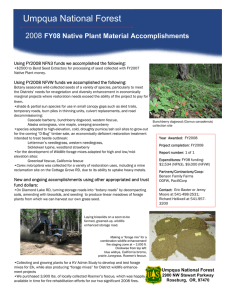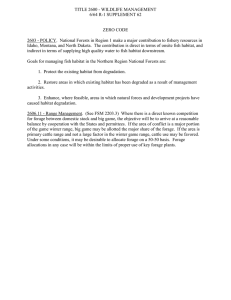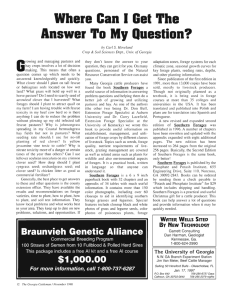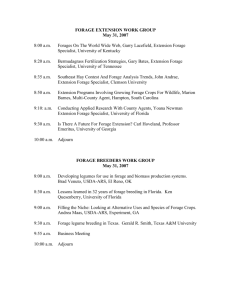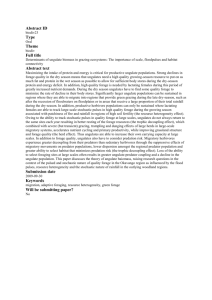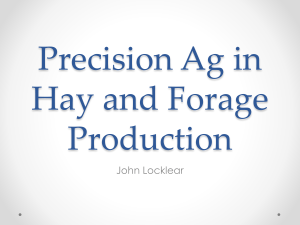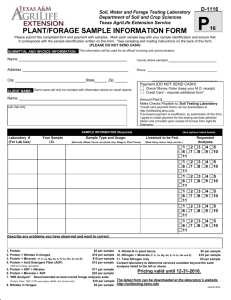Document 10912055
advertisement
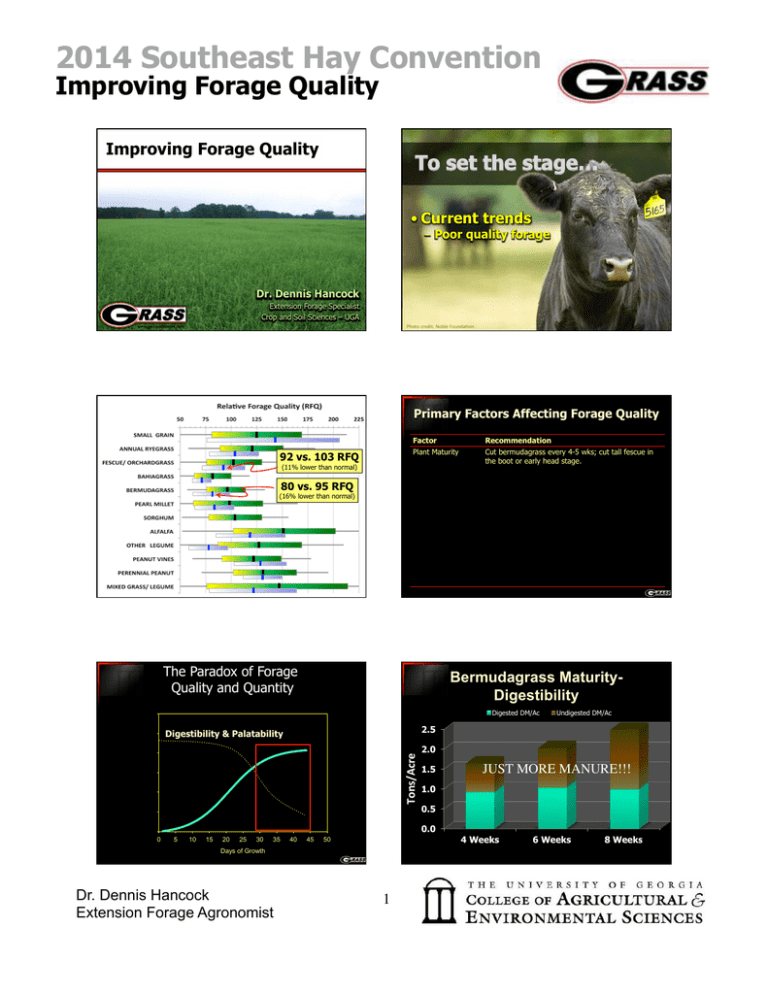
2014 Southeast Hay Convention Improving Forage Quality Improving Forage Quality To set the stage… • Current trends - Poor quality forage Dr. Dennis Hancock Extension Forage Specialist Crop and Soil Sciences – UGA Photo credit: Noble Founda3on. Primary Factors Affecting Forage Quality 92 vs. 103 RFQ (11% lower than normal) 80 vs. 95 RFQ (16% lower than normal) Factor Recommendation Plant Maturity Cut bermudagrass every 4-5 wks; cut tall fescue in the boot or early head stage. Forage Species Use the highest-quality species that will persist in your environment. Bale Storage Protect bales from rainfall and weathering during storage (i.e., barn, tarp, etc.) Rain During Curing Avoid cutting if significant rainfall (> 0.50 inches) is predicted during curing. Moisture at Baling Allow forage to dry to the appropriate moisture (Round: 15%; Square: 18%) Fertilization Provide fertilizer based on soil test recommendations Variety Use varieties that have proven to be higher in quality. The Paradox of Forage Quality and Quantity Bermudagrass MaturityDigestibility Digested DM/Ac 12000 Growth Curve 8000 Tons/Acre Forage Mass (dry lbs/acre) 2.5 Digestibility & Palatability 10000 6000 4000 2000 0 2.0 1.5 5 10 15 20 25 30 35 40 45 50 Days of Growth Dr. Dennis Hancock Extension Forage Agronomist JUST MORE MANURE!!! 1.0 0.5 0.0 0 Undigested DM/Ac 4 Weeks Majority of hay harvested at hard seed stage Only truly applicable with spring harvest 1 6 Weeks 8 Weeks 2014 Southeast Hay Convention Improving Forage Quality Harvest Timing Recommendations Be Careful of Cutting Height • Hybrid Bermudagrass - - 1st cut at 12-16 inches Subsequent cuttings at 3.5-5 week intervals • Tall fescue, ryegrass, orchardgrass, etc. - - - Spring cut at early flower stage Mid to late boot stage for higher quality Subsequent cuttings at 10-12 inches (better quality) • Alfalfa - - Spring cut at when 10-20% of plants are blooming Cut at late bud – 10% bloom stage Primary Factors Affecting Forage Quality Write this down in BIG BOLD letters! “GRASS GROWS GRASS.” Quality Differences in the Major Forage Species Digestible DM, % 40 Dr. Dennis Hancock Extension Forage Agronomist High Production Legumes Tropical Annual Grasses 50 Tropical Perennial Grasses 60 Cool Season Perennial Grasses 70 Cool Season Annual Grasses 80 Mod. Production Maint. 2 Factor Recommendation Plant Maturity Cut bermudagrass every 4-5 wks; cut tall fescue in the boot or early head stage. Forage Species Use the highest-quality species that will persist in your environment. Bale Storage Protect bales from rainfall and weathering during storage (i.e., barn, tarp, etc.) Rain During Curing Avoid cutting if significant rainfall (> 0.50 inches) is predicted during curing. Moisture at Baling Allow forage to dry to the appropriate moisture (Round: 15%; Square: 18%) Fertilization Provide fertilizer based on soil test recommendations Variety Use varieties that have proven to be higher in quality. 2014 Southeast Hay Convention Improving Forage Quality Primary Factors Affecting Forage Quality Factor Recommendation Plant Maturity Cut bermudagrass every 4-5 wks; cut tall fescue in the boot or early head stage. Forage Species Use the highest-quality species that will persist in your environment. Bale Storage Protect bales from rainfall and weathering during storage (i.e., barn, tarp, etc.) Rain During Curing Avoid cutting if significant rainfall (> 0.50 inches) is predicted during curing. Moisture at Baling Allow forage to dry to the appropriate moisture (Round: 15%; Square: 18%) Fertilization Provide fertilizer based on soil test recommendations Variety Use varieties that have proven to be higher in quality. 14 inches ~74% of the bales volume is contained in that 14 inches. Moisture distribution of mixed grass-legume round bales stored on the ground Moisture distribution of mixed grass-legume round bales stored on the ground vs. elevated % Moisture % Moisture Twine Wrapped Twine Wrapped Net Wrapped Shinners, University of Wisconsin Shinners, University of Wisconsin The Effect of Rainfall on DM Loss Recommendation Plant Maturity Cut bermudagrass every 4-5 wks; cut tall fescue in the boot or early head stage. Forage Species Use the highest-quality species that will persist in your environment. Bale Storage Protect bales from rainfall and weathering during storage (i.e., barn, tarp, etc.) Rain During Curing Avoid cutting if significant rainfall (> 0.50 inches) is predicted during curing. Moisture at Baling Allow forage to dry to the appropriate moisture (Round: 15%; Square: 18%) Fertilization Provide fertilizer based on soil test recommendations Variety Use varieties that have proven to be higher in quality. Dr. Dennis Hancock Extension Forage Agronomist DM Loss, % Primary Factors Affecting Forage Quality Factor On a Pallet Scarbrough et al., 2005 3 Rainfall, in. 2014 Southeast Hay Convention Improving Forage Quality Crop Moisture Lessens Rain Damage on Bermudagrass The Effect of Rain on Tall Fescue Hay Turner et al., 2003 Rainfall, in. Scarbrough et al., 2005 Primary Factors Affecting Forage Quality Protect bales from rainfall and weathering during storage (i.e., barn, tarp, etc.) Rain During Curing Avoid cutting if significant rainfall (> 0.50 inches) is predicted during curing. Moisture at Baling Allow forage to dry to the appropriate moisture (Round: 15%; Square: 18%) Fertilization Provide fertilizer based on soil test recommendations Variety Use varieties that have proven to be higher in quality. Heat Yield and Digestibility of Bermudagrass Hybrids Primary Factors Affecting Forage Quality Cut bermudagrass every 4-5 wks; cut tall fescue in the boot or early head stage. Forage Species Use the highest-quality species that will persist in your environment. Bale Storage Protect bales from rainfall and weathering during storage (i.e., barn, tarp, etc.) Rain During Curing Avoid cutting if significant rainfall (> 0.50 inches) is predicted during curing. Moisture at Baling Allow forage to dry to the appropriate moisture (Round: 15%; Square: 18%) Variety Use varieties that have proven to be higher in quality. Variety Use varieties that have proven to be higher in quality. Dr. Dennis Hancock Extension Forage Agronomist 140 Yield Digestibility 120 100 80 60 40 20 0 Co as ta l Recommendation Plant Maturity Differences (%) Relative to Coastal Factor Heat-Damaged Protein 4 44 Bale Storage ft on Use the highest-quality species that will persist in your environment. Ti Forage Species DM Intake Useable Protein m m on Cut bermudagrass every 4-5 wks; cut tall fescue in the boot or early head stage. Co Recommendation Plant Maturity Heat Damage to Crude Protein Protein Factor ificant. Variety l 59.7 us se l 63.2 re, Not Sign R Digestibility, % 76% Moistu ia 76.0 Al ic 68.1 oisture 13% M 85 NDF, % Intake, % of b.w. oisture 40% M Ti ft on Rain Damage 1.92 NDF, % No Rain 2.10 2014 Southeast Hay Convention Improving Forage Quality Primary Factors Affecting Forage Quality Factor Recommendation Plant Maturity Cut bermudagrass every 4-5 wks; cut tall fescue in the boot or early head stage. Forage Species Use the highest-quality species that will persist in your environment. Bale Storage Protect bales from rainfall and weathering during storage (i.e., barn, tarp, etc.) Rain During Curing Avoid cutting if significant rainfall (> 0.50 inches) is predicted during curing. Moisture at Baling Allow forage to dry to the appropriate moisture (Round: 15%; Square: 18%) Variety Use varieties that have proven to be higher in quality. Fertilization Provide fertilizer based on soil test recommendations Does fertility or harvest timing affect quality more?- Crude Protein (4X as much N) Bromegrass Colovos et al. 1961 Does fertility or harvest timing affect quality more?- Digestibility Effect of N Rates on Bermudagrass CP & Digestibility (3.8 X as much N) 20 15 10 5 0 Bromegrass Colovos et al. 1961 Burton et al. Recommendation Plant Maturity Cut bermudagrass every 4-5 wks; cut tall fescue in the boot or early head stage. Forage Species Use the highest-quality species that will persist in your environment. Bale Storage Protect bales from rainfall and weathering during storage (i.e., barn, tarp, etc.) Rain During Curing Avoid cutting if significant rainfall (> 0.50 inches) is predicted during curing. Moisture at Baling Allow forage to dry to the appropriate moisture (Round: 15%; Square: 18%) Variety Use varieties that have proven to be higher in quality. Fertilization Provide fertilizer based on soil test recommendations Dr. Dennis Hancock Extension Forage Agronomist 0 DigesKbility 400 1400 Annual lbs N/year Anti-Quality Factors Primary Factors Affecting Forage Quality Factor Crude Protein Nitrate Toxicity • Nitrate (NO3-) is reduced to nitrite (NO22-) by microbes in the digestive tract • Once in the bloodstream, (NO2) binds with hemoglobin (creating methemoglobin) § Prevents the normal transfer of oxygen. § Bluish color of mucous membranes, rapid and difficult breathing, a rapid pulse (>150 bpm), tremors,… death. § Dark brown or “chocolate-colored” blood. 5 70 68 66 64 62 60 58 56 54 52 50 DigesKbility, % Crude Protein, % 25 2014 Southeast Hay Convention Improving Forage Quality Nitrate in forage fed to beef cattle. Forage Nitrate (ppm dry forage) Guidance < 4500 Safe to feed with adequate feed and water 4,500 to < 6,500 Safe under most condi3ons, but if feeding pregnant animals limit to half (1/2) ra3on 6,500 to < 9,000 Limit to half (1/2) ra3on 9,000 to < 15,000 Limit to third (1/3) ra3on 15,000 to < 18,000 Limit to quarter (1/4) ra3on > 18,000 Poten3ally lethal, very risky Subclinical Nitrate Toxicosis • Open cow that goes unexplained • Lower milk production or gain. Anti-Quality Factors Anti-Quality Factors Prussic Acid Toxicity Fescue Endophyte/Alkaloids • Certain plants (e.g., the sorghum species, black cherry, etc.) contain cyanogenic glycosides that can release hydrocyanic acid (HCN). • Assume that it is present unless known not to be. • Ergot alkaloids cause fescue toxicosis § Reduced animal performance, poor conception, excess heat stress, vasoconstriction, retained hair coat, retained placenta, aglactica, loss of hooves, loss of tail switch, etc. • HCN in rumen -> bloodstream -> combines with hemoglobin to form cyanoglobin. § HCN prevents transfer of O2 from hemoglobin to the tissues. § Symptoms: inc. respiration rate, pulse rate, muscular tremors, blue coloration around mouth, ... sudden death. § Bright red color of the blood. • Conc. can be tested § Agronostics, LLC (Watkinsville, GA) www.georgiaforages.com GeorgiaForages.com Email Updates 1-800-ASK-UGA1 www.georgiaforages.com Dr. Dennis Hancock Extension Forage Agronomist 6
